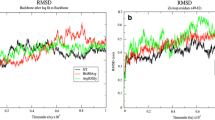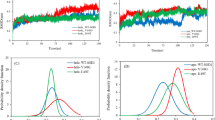Abstract
Mutant superoxide dismutase 1 (SOD1) may form cyclic structures due to its greater instability from aberrant demetallization and oxidation of cysteine bonds. This cyclic structure may allow SOD1 to form ion channels on membranes such as the mitochondrial membrane, causing imbalances in the concentration of intracellular ions as a potential mechanism for the progressive neuron death involved in amyotrophic lateral sclerosis (ALS). Using docking programs within modeling software, models of mutant SOD1 dimers and eventually ring oligomers were constructed based on known descriptions of such structures in addition to information on the orientation of the models associated with a membrane. The resulting structure consists of a ring of four demetallated mutant SOD1 dimers with cross-linked disulfide bonds. Stability of the octamer model was supported by the molecular dynamics simulations. Further analysis of the octamer model indicated that its inner- and outer-pore diameters were stable, matching the dimensions of known SOD1 ion channels.







Similar content being viewed by others

Data availability
Data are available within the article.
Code availability
N/A.
References
Shi P, Ström A, Gal J, Zhu H (2010) Effects of ALS-related SOD1 mutants on dynein- and KIF5-mediated retrograde and anterograde axonal transport. Biochim Biophys Acta 1802(9):707–716. https://doi.org/10.1016/j.bbadis.2010.05.008
Forsberg K, Andersen PM, Marklund SL, Brännström T (2011) Glial nuclear aggregates of superoxide dismutase-1 are regularly present in patients with amyotrophic lateral sclerosis. Acta Neuropathol 121(5):623–634. https://doi.org/10.1007/s00401-011-0805-3
Mitsumoto H, Factor-Litvak P, Andrews H, Goetz RR, Andrews L, Rabkin JG, McElhiney M, Nieves J, Santella RM, Murphy J, Hupf J, Singleton J, Merle D, Kilty M, Heitzman D, Bedlack RS. Miller RG, Katz JS, Forshew D, Barohn RJ, … ALS COSMOS Study Group (2014) ALS Multicenter Cohort Study of Oxidative Stress (ALS COSMOS): study methodology, recruitment, and baseline demographic and disease characteristics. Amyotroph Lateral Scler Frontotemporal Degener 15(3–4):192–203. https://doi.org/10.3109/21678421.2013.864312
Foran E, Trotti D (2009) Glutamate transporters and the excitotoxic path to motor neuron degeneration in amyotrophic lateral sclerosis. Antioxid Redox Signal 11(7):1587–1602. https://doi.org/10.1089/ars.2009.2444
Redle RL, Dokholyan N (2012) The complex molecular biology of amyotrophic lateral sclerosis (ALS). Prog Mol Biol Transl Sci 107:215–262. https://doi.org/10.1016/B978-0-12-385883-2.00002-3
Synofzik M, Fernández-Santiago R, Maetzler W, Schöls L, Andersen PM (2010) The human G93A SOD1 phenotype closely resembles sporadic amyotrophic lateral sclerosis. J Neurol Neurosurg Psychiatry 81(7):764–767. https://doi.org/10.1136/jnnp.2009.181719
Oztug Durer ZA, Cohlberg JA, Dinh P, Padua S, Ehrenclou K, Downes S, Tan JK, Nakano Y, Bowman CJ, Hoskins JL, Kwon C, Mason AZ, Rodriguez JA, Doucette PA, Shaw BF, Valentine JS (2009) Loss of metal ions, disulfide reduction and mutations related to familial ALS promote formation of amyloid-like aggregates from superoxide dismutase. PLoS ONE 4(3):e5004. https://doi.org/10.1371/journal.pone.0005004
Stevens JC, Chia R, Hendriks WT, Bros-Facer V, van Minnen J, Martin JE, Jackson GS, Greensmith L, Schiavo G, Fisher EM (2010) Modification of superoxide dismutase 1 (SOD1) properties by a GFP tag–implications for research into amyotrophic lateral sclerosis (ALS). PLoS ONE 5(3):e9541. https://doi.org/10.1371/journal.pone.0009541
Zhu C, Beck MV, Griffith JD, Deshmukh M, Dokholyan NV (2018) Large SOD1 aggregates, unlike trimeric SOD1, do not impact cell viability in a model of amyotrophic lateral sclerosis. Proc Natl Acad Sci USA 115(18):4661–4665. https://doi.org/10.1073/pnas.1800187115
Arnesano F, Banci L, Bertini I, Martinelli M, O’Halloran FY, TV. (2004) The unusually stable quaternary structure of human Cu, Zn-superoxide dismutase 1 is controlled by both metal occupancy and disulfide status. J Biol Chem 279:47998–48003. https://doi.org/10.1074/jbc.M406021200
Furukawa Y, Fu R, Deng HX, Siddique T, O’Halloran TV (2006) Disulfide cross-linked protein represents a significant fraction of ALS-associated Cu, Zn-superoxide dismutase aggregates in spinal cords of model mice. Pro. Nat Acad Sci USA 103:7148–7153. https://doi.org/10.1073/pnas.0602048103
Tsigelny IF, Sharikov Y, Miller MA, Masliah E (2008) Mechanism of alpha-synuclein oligomerization and membrane interaction: theoretical approach to unstructured proteins studies. Nanomedicine 4(4):350–357. https://doi.org/10.1016/j.nano.2008.05.005
Crews L, Tsigelny I, Hashimoto M, Masliah E (2009) Role of synucleins in Alzheimer’s disease. Neurotox Res 16(3):306–317. https://doi.org/10.1007/s12640-009-9073-6
Allen MJ, Lacroix JJ, Ramachandran S, Capone R, Whitlock JL, Ghadge GD, Arnsdorf MF, Roos RP, Lal R (2012) Mutant SOD1 forms ion channel: implications for ALS pathophysiology. Neurobiol Dis 45(3):831–838. https://doi.org/10.1016/j.nbd.2011.08.031
Lomize MA, Pogozheva ID, Joo H, Mosberg HI, Lomize AL (2012) OPM database and PPM web server: resources for positioning of proteins in membranes. Nucleic Acids Res 40(Database issue):D370-376. https://doi.org/10.1093/nar/gkr703
Desta IT, Porter KA, **a B, Kozakov D, Vajda S (2020) Performance and its limits in rigid body protein–protein docking. Structure 28(9):1071-1081.e3. https://doi.org/10.1016/j.str.2020.06.006
Vajda S, Yueh C, Beglov D, Bohnuud T, Mottarella SE, **a B, Hall DR, Kozakov D (2017) New additions to the ClusPro server motivated by CAPRI. Proteins 85(3):435–444. https://doi.org/10.1002/prot.25219
Kozakov D, Beglov D, Bohnuud T, Mottarella S, **a B, Hall DR, Vajda S (2013) How good is automated protein docking? Proteins 81(12):2159–2166. https://doi.org/10.1002/prot.24403
Kozakov D, Hall DR, **a B, Porter KA, Padhorny D, Yueh C, Beglov D, Vajda S (2017) The ClusPro web server for protein-protein docking. Nat Protoc 12(2):255–278. https://doi.org/10.1038/nprot.2016.169
Case DA, Brozell SR, Cerutti DS, Cheatham TE III, Cruzeiro VWD, Darden TA, DukeDG, Gilson MK, Gohlke H, Goetz AW, Greene D, Harris R, Homeyer N, Huang Y, Izadi S, Kurtzman AKT, Lee TS, LeGrand S, Li P, Lin C, Liu J, Luchko T, Luo DJ, Mermelstein KMM, Miao Y, Monard G, Nguyen C, Nguyen H, Omelyan I, Onufriev A, Pan R, Qi DRR, Roitberg A, Sagui C, Schott-Verdugo S, Shen J, Simmerling CL, Smith J, Salomon Ferrer R, Swails J, Walker RC, Wang J, Wei H, Wolf RM, Wu X, **ao L, York DM, Kollman PA (2018) AMBER 2018, University of California, San Francisco. https://ambermd.org/. Accessed 22 Apr 2020
Maier JA, Martinez C, Kasavajhala K, Wickstrom L, Hauser KE, Simmerling C (2015) ff14SB: Improving the accuracy of protein side chain and backbone parameters from ff99SB. J Chem Theory Comput 11(8):3696–3713. https://doi.org/10.1021/acs.jctc.5b00255
Roe DR, Cheatham TE 3rd (2013) PTRAJ and CPPTRAJ: software for processing and analysis of molecular dynamics trajectory data. J Chem Theory Comput 9(7):3084–3095. https://doi.org/10.1021/ct400341p
Sehnal D, SvobodováVařeková R, Berka K, Pravda L, Navrátilová V, Banáš P, Ionescu CM, Otyepka M, Koča J (2013) MOLE 2.0: advanced approach for analysis of biomacromolecular channels. J Cheminformatics 5(1):39. https://doi.org/10.1186/1758-2946-5-39
Elam JS, Taylor AB, Strange R, Antonyuk S, Doucette PA, Rodriguez JA, Hasnain SS, Hayward LJ, Valentine JS, Yeates TO, Hart PJ (2003) Amyloid-like filaments and water-filled nanotubes formed by SOD1 mutant proteins linked to familial ALS. Nat Struct Biol 10:461–467. https://doi.org/10.1038/nsb935
Lashuel HA, Hartley D, Petre BM, Walz T, Lansbury PT Jr (2002) Neurodegenerative disease: amyloid pores from pathogenic mutations. Nature 418:291. https://doi.org/10.1038/418291a
Author information
Authors and Affiliations
Contributions
Molecular modeling and writing of the article: AZ, interpretation of the results: AZ and VLK, molecular dynamics simulations: KT, modeling of dimers and revising of the article: IFT and VLK.
Corresponding author
Ethics declarations
Consent to participate
The manuscript is approved by all authors for publication.
Consent for publication
The consent for publication was obtained from all participants.
Conflict of interest
The authors declare no competing interests.
Additional information
Publisher’s note
Springer Nature remains neutral with regard to jurisdictional claims in published maps and institutional affiliations.
Rights and permissions
About this article
Cite this article
Zhang, A., Teigen, K., Kouznetsova, V.L. et al. Modeling of mutant superoxide dismutase 1 octamers with cross-linked disulfide bonds. J Mol Model 28, 89 (2022). https://doi.org/10.1007/s00894-022-05072-4
Received:
Accepted:
Published:
DOI: https://doi.org/10.1007/s00894-022-05072-4



